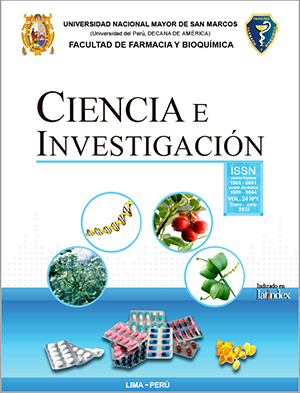Determination of cadmium in onion (Allium cepa) in Metropolitan Lima
DOI:
https://doi.org/10.15381/ci.v24i2.22519Keywords:
Cadmium, contamination in food, Allium cepaAbstract
A study was carried out to determine cadmium in onion (Allium cepa) in districts of Metropolitan Lima. For the execution of the study, 30 samples were collected of which 10 of them are from North Lima (San Martin de Porres, Los Olivos, Independencia, Comas and Puente Piedra), 10 samples from Lima Center (Cercado de Lima, Jesús María, Pueblo Libre, La Victoria and Rímac) and 10 exhibitions in South Lima (Chorrillos, Villa María del Triunfo, Villa el Salvador, San Juan de Miraflores and Surco). 2 random samples were taken per district and the place of origin of the same was inquired. Cadmium quantification was performed by the atomic absorption method - Graphite Furnace at the Chemical Analysis Services Unit - USAQ (Universidad Nacional Mayor de San Marcos). The minimum and maximum cadmium concentration in onion was 0,02 mg / mg and 0,11 mg / kg, respectively; In addition, the average (0,06 mg / kg) was obtained, exceeding the maximum level established by the WHO / FAO (Codex Alimentarius; Cd = 0,05 mg / kg). Finally, it was determined that the onion samples from Arequipa accumulated a higher concentration of cadmium than those from Lima (Huaral) and La Libertad (Trujillo). The results obtained show that the average concentration of cadmium present in onions exceeds the international standard, which represents a risk for the population. and, therefore, its consumption by the Peruvian population.
Downloads
Published
Issue
Section
License
Copyright (c) 2022 Mayra Juan De Dios, Mesías García, Gloria Marín, Denisse Olórtegui

This work is licensed under a Creative Commons Attribution 4.0 International License.
LOS AUTORES RETIENEN SUS DERECHOS:
- Los autores retienen sus derechos de marca y patente, y tambien sobre cualquier proceso o procedimiento descrito en el artículo.
- Los autores retienen el derecho de compartir, copiar, distribuir, ejecutar y comunicar públicamente el articulo publicado en la Revista Ciencia e Investigación (por ejemplo, colocarlo en un repositorio institucional o publicarlo en un libro), con un reconocimiento de su publicación inicial en la Revista Ciencia e Investigación.
- Los autores retienen el derecho a hacer una posterior publicación de su trabajo, de utilizar el artículo o cualquier parte de aquel (por ejemplo: una compilación de sus trabajos, notas para conferencias, tesis, o para un libro), siempre que indiquen la fuente de publicación (autores del trabajo, revista, volumen, numero y fecha).






